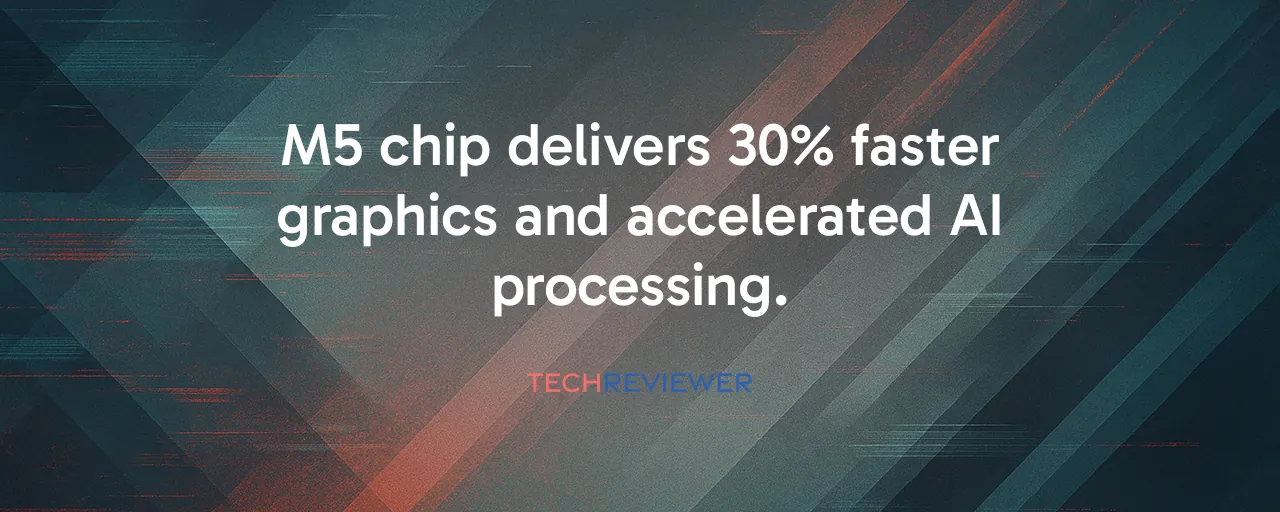Consistent Progress in Apple Silicon
Apple introduced the M5 chip in mid-October 2025 across the 14-inch MacBook Pro, iPad Pro, and Apple Vision Pro. This release marks nearly five years since the M1 debuted in 2020. Each generation has brought measurable improvements in CPU, GPU, and efficiency. The M5 continues that pattern with gains that add up over time.
Multithreaded CPU performance rises 15 percent compared to the M4. Graphics see a 30 percent increase thanks to a new 10-core GPU design. Apple builds these chips on a third-generation 3-nanometer process from TSMC. Memory bandwidth reaches 153 GB per second, a 30% jump.
Performance Details in Real Workloads
Benchmarks reveal practical benefits. Large language models process first tokens 3.6 times faster than on M4. Video enhancement in Topaz runs 1.8 times quicker. Blender rendering with ray tracing completes 1.7 times sooner. Adobe Premiere Pro handles AI speech tasks 2.9 times faster.
The chip includes six efficiency cores at 3 GHz and up to four performance cores. A 16-core Neural Engine speeds machine learning. Each GPU core now has a Neural Accelerator, pushing AI compute over four times higher than before.
Lessons From Butterfly Keyboards
Apple shipped butterfly mechanism keyboards in MacBooks from 2015 to 2019. Keys often stuck or repeated due to dust. The company ran a service program to fix affected models across several years. Regular product cycles continued during this period, yet the design flaw persisted until Apple switched back to scissor switches in 2019.
This example shows that frequent updates alone do not prevent mistakes. Hardware choices can still lead to reliability issues even with annual releases.
Intel-Era Mac Pro Delays
The 2013 Mac Pro used a cylindrical design and received no major refresh until 2019. Professionals worked with outdated hardware for six years. Dependence on Intel's roadmap delays and GPU partner availability created this extended gap, leaving a critical product line stagnant.
Apple Silicon changed that. By controlling its own chip development, Apple eliminated dependency on external timelines. This shift enables more reliable release schedules and avoids the prolonged waits that frustrated pro users in the past.
Buyer Confidence With Regular Cycles
People purchasing a Mac today know a new model arrives roughly every year or 18 months. This predictability removes guesswork and prevents buyer's remorse from purchasing just before a refresh.
Enterprise teams plan budgets and fleet deployments around expected timelines. Developers optimize code with confidence in minimum performance levels across the installed base, knowing hardware capabilities progress steadily.
Content Creation and Review Challenges
Reviewers and tech content creators rely on standout features to attract views and engagement. Incremental changes produce less exciting videos or articles, leading some to label the M5 as another small step forward.
Apple prioritizes steady gains over splashy reveals, spacing major events for truly new products while issuing spec updates quietly. This approach serves users better but creates challenges for media that depends on novelty.
Thermal and Efficiency Trade-Offs
The M5 runs at 30 watts under load, up from 25 watts for M4. Temperatures reach 99 degrees Celsius, matching prior thermal limits. Efficiency cores now feature a 6 MB L2 cache cluster, enabling faster background processing without waking performance cores.
Higher power use suggests efficiency gains are slowing compared to early Apple Silicon transitions. Future designs may require active cooling in thinner devices like the MacBook Air to sustain performance.
Market Context and Competition
Gartner forecasts AI PC shipments to grow 165% in 2025, reaching 43% of all PC shipments. Qualcomm, Intel, and AMD release their own annual mobile chips optimized for AI workloads. Windows 11 supports these processors as Windows 10 support ends.
Apple's vertical control lets it set its own pace. The M5 positions devices for AI tasks with on-device processing through the Neural Engine and GPU, reducing reliance on cloud services and enhancing privacy.
